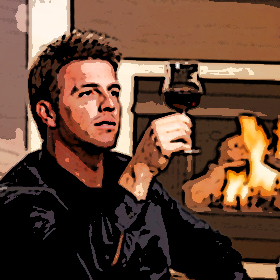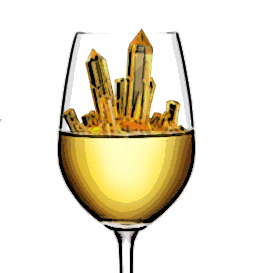Visual Wine Inspection, Bubble Trouble & Cosmic Crystals.
Chapter Three, Part Four.
 The first step of wine analysis is to take a good look at your wine. For this you will need an acceptable wine glass. You may be emotionally attached to that old Flintstones tumbler you’ve had since grade school, but it’s time to buy some nice stemware and part ways with Fred and Barney.
The first step of wine analysis is to take a good look at your wine. For this you will need an acceptable wine glass. You may be emotionally attached to that old Flintstones tumbler you’ve had since grade school, but it’s time to buy some nice stemware and part ways with Fred and Barney.
A good-sized, tulip-shaped glass with a thin rim will do nicely for most wines, providing it is clear. Avoid glasses that are tinted or painted. I’m sorry gentlemen but the logo of your favorite sports franchise may be appropriate glassware for the man-cave, but it’s unacceptable on your wine glasses. I know you’re reluctant to give up the team logo but if your wives were on the Pulitzer Prize committee, this stipulation would make Wine Snark a shoe-in for the award.
You’ve probably seen ads featuring a cosmopolitan group of friends enjoying wine together. Remember the handsome guy holding his glass up to the light and looking at it from below? He’s supposed to be the wine expert in the group that everyone envies. If you want to be the wine guy in your group, don’t analyze a glass of wine by holding it up to the light. The pretentious guy in the ad is probably compensating for his petit pineau.
To inspect wine, hold it over a white surface like a table cloth or a napkin. Tilt the glass away from you and look down at it (the way my friends looked at me after sending my kid to community college). Looking at wine this way will reveal the clues you’re looking for as well as let your friends know you’re not the pretentious guy compensating for some physical shortcoming.
So now you know how to look good when you’re inspecting wine, but what are you looking for? This reminds me of the advice I gave my son when I was teaching him to drive. I tried to explain that he must look over his right shoulder when he’s in reverse. His response was, “Don’t tell me how to drive when I’m texting!”
For months he neglected the all-important step of looking over his shoulder while backing up. One day I lost my temper when he put the car in reverse then turned and looked straight down at the floor.
“Why are you looking at the floor?” I cried.
“Don’t get mad at me Dad. You never told me what I’m looking for!”
I don’t want to make the same mistake in this blog because someone could get seriously hurt. So here it is, when inspecting wine you’re looking for clarity, intensity, color, and oncoming traffic if you’re drinking with your car in reverse.
Cosmic Crystals and Bubble Trouble
 While visually inspecting wine you may find small crystals floating in your glass or even stuck to the cork like tiny cosmic stalactites. Crystals in wine simply means your wine has found inner peace and harmony with the cosmic universe and contains celestial energy as well as magical healing powers.
While visually inspecting wine you may find small crystals floating in your glass or even stuck to the cork like tiny cosmic stalactites. Crystals in wine simply means your wine has found inner peace and harmony with the cosmic universe and contains celestial energy as well as magical healing powers.
Of course there are some in the wine trade who believe wine crystals have more to do with common chemistry than ancient astronauts. In the name of fair and honest journalism, this is what those kooks have to say on the subject.
Wine contains naturally occurring tartaric acid which can crystallize when exposed to a dramatic temperature change. Because this crystallization can happen at any time, commercial winemakers may put their wines through a process called cold stabilization before bottling. This sub-freezing process causes tartaric acids to crystallize so they can be separated from the wine. Whether this transformation happens before bottling or after is irrelevant as the crystals are completely harmless and they don’t affect the quality of the wine. Besides, you may find the crystal covered cork looks pretty groovy next to your incense burner.
When inspecting wine you may notice tiny bubbles clinging to the sides of your wine glass like terrified preschoolers on a runaway Tilt-A-Whirl. Bubbles are to be expected if you happen to be looking at a sparkling wine or at wine made in a frizzante style. Frizzante is not an Italian hair product but rather a term for wine produced with a light effervescence. Prosecco is a common example of frizzante but many other wines, including Lambrusco and Portugal’s Vino Verde, are often produced in this manner.
But when you see bubbles where they shouldn’t be, it’s a tip-off to a serious flaw that can have explosive consequences. If there is any trace of sugar and yeast left in wine after bottling, a secondary fermentation can occur inside the bottle. The byproduct of fermentation is carbon dioxide gas; AKA bubbles.
I used to sell a slightly sweet, frizzante-styled Italian red wine made from the Brachetto grape. One day I was standing in my store with an exasperating employee I’ll call Mike because that’s his name. I was looking at the Brachetto and thinking, “That wine just isn’t selling. I should do something to get rid of it.” At that moment the bottle exploded. Mike and I ducked for cover as foamy pink liquid filled the air like a flock of flamingos over a wine bottle Serengeti.
There was obviously sugar in the bottle (because it’s a sweet wine) but there was also some stubborn yeast hiding in there which triggered the fermentation process. The carbon dioxide built up inside the bottle like trapped gas after an all night beer and burrito binge. You probably know the feeling, something’s got to blow and in this case it was the bottle.
“Holy cow!” I said to Mike. “I was just staring at that bottle and thinking I should get rid of it, when POW, it exploded.”
I turned, fixed him with an icy stare and said, “You know, I sometimes look at you and think the same thing.”























Very informative, and funny! Excellent post! Thanks!
Thanks Sean. I sometimes get questions about tartaric crystals so I thought it might be a useful post. The anecdotes about driving with my son and the exploding bottle are both true stories but (this may be hard to believe), I made up the stuff about cosmic healing powers.